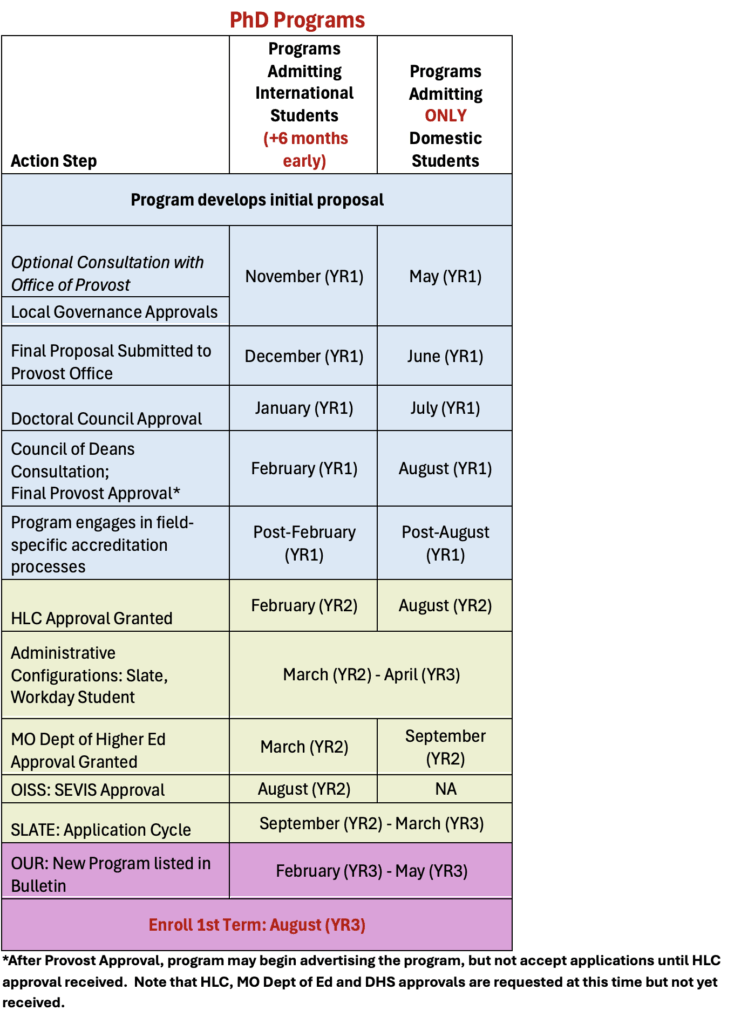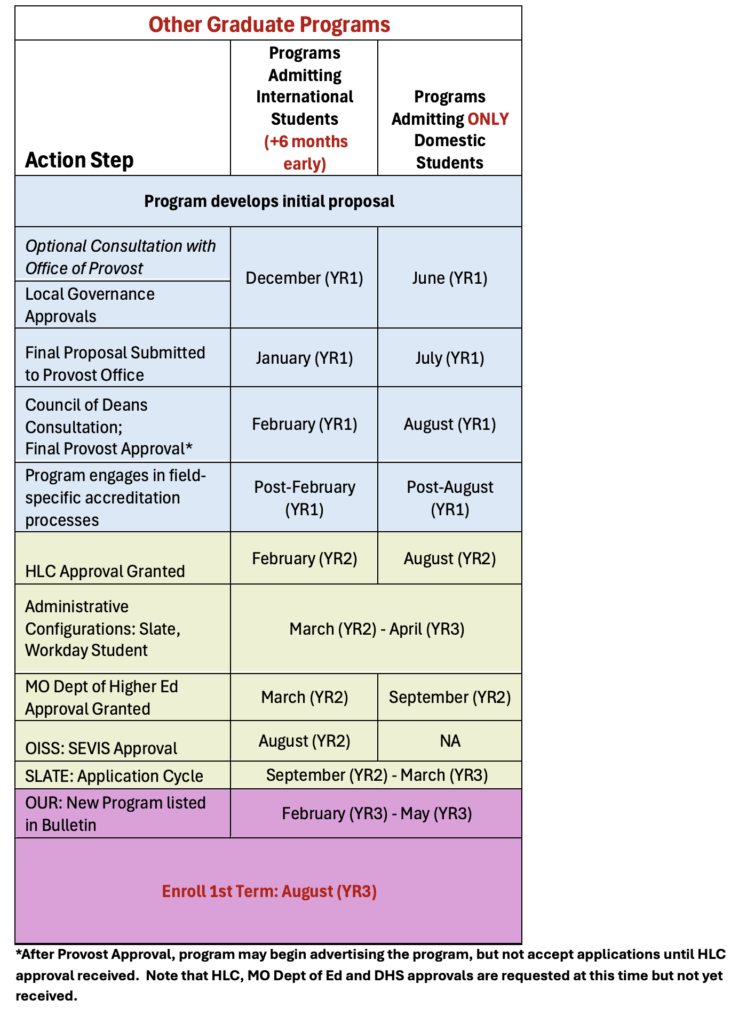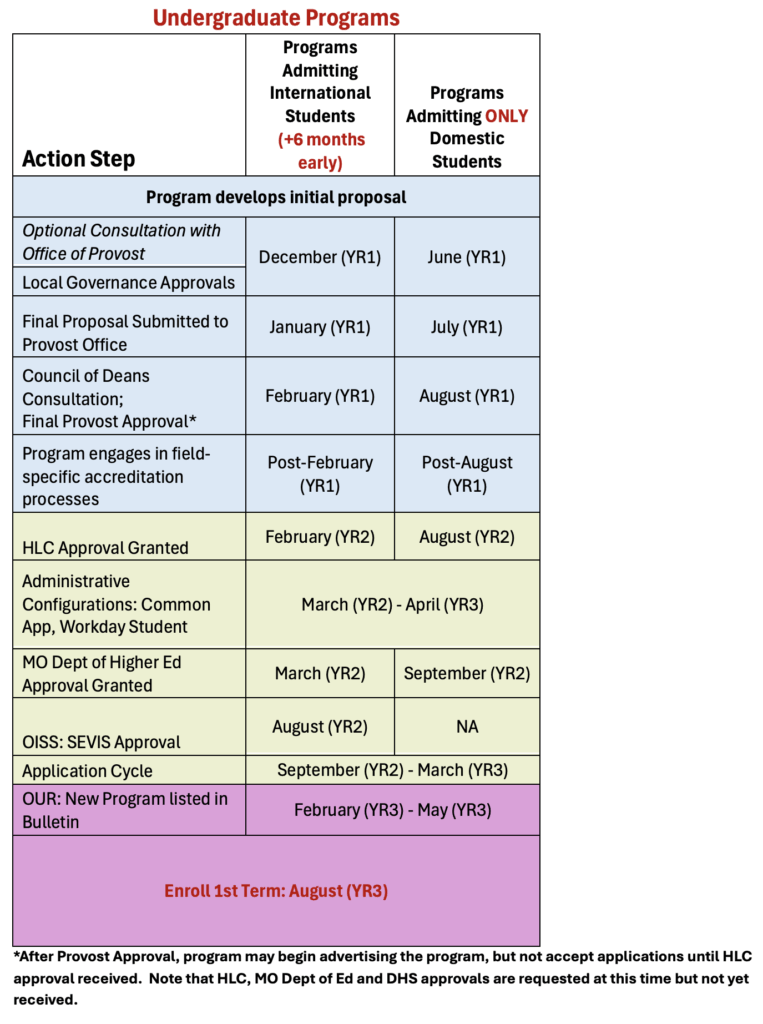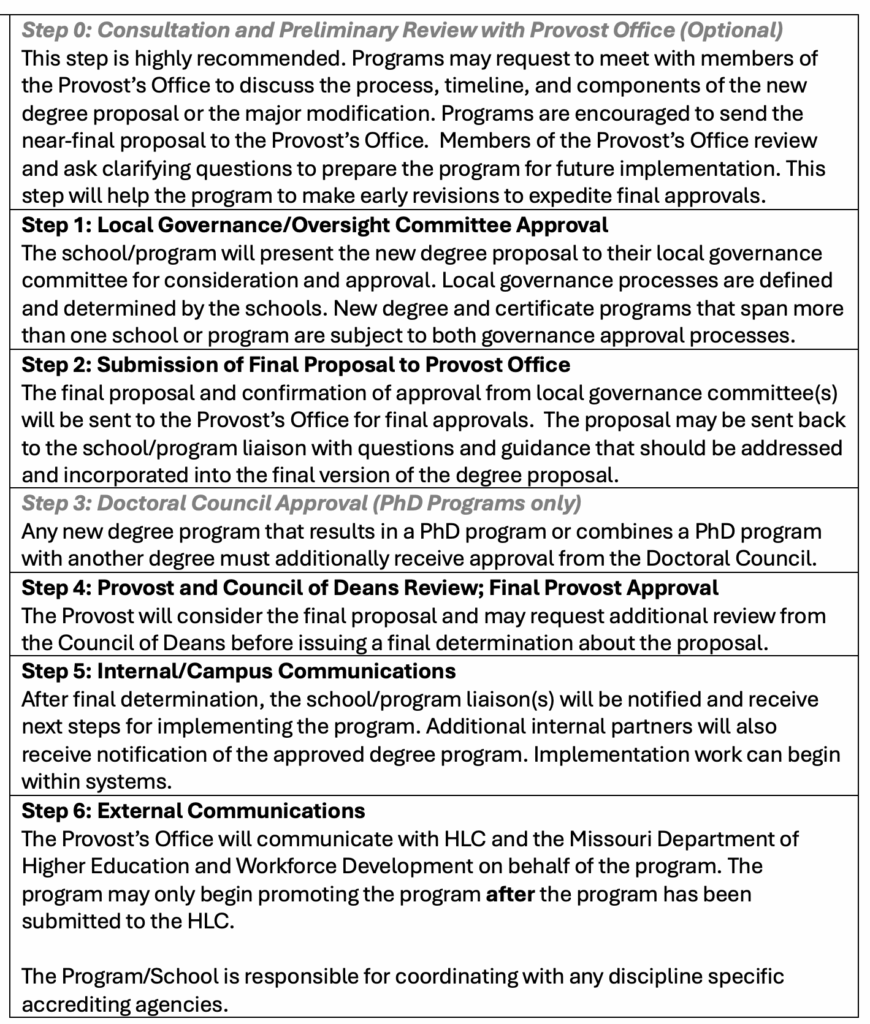Overview
All new degrees and certificates (including joint and dual degree) and changes to existing degree programs that meet certain criteria require Provost-level approval. Schools can propose the creation of new degree or certificate programs by following the process outlined below. For any new degree or certificate program, there are a number of compliance-related steps, including approval from accreditation bodies and the federal government for student visas that require significant lead-time before students may enroll in a new program. Please carefully read the Timeline Considerations section and begin this process with ample time before the desired first admission cycle.
In 2025, this process was updated to provide enhanced guidance to clarify timelines and expectations considering the implementation of Workday and changes in external agencies’ processing times. A more robust set of guidelines and expectations were also developed to support curricular innovation that aligns with significant degree modification. Finally, a process for collecting information related to program closure was created. Questions about this document or any new degree/certificate, significant curricular modifications, or program closures can be directed to the Assistant Provost for Academic Compliance & Integrity or the Project Manager for Academic Compliance & Accreditation.
Timeline Summary
To clarify the expectations of the internal and external processes for new degree programs, the timeline outlined below considers the processes of admissions, Higher Learning Commission (HLC) approvals, Student and Exchange Visitor Program (SEVP) approvals, and configuration in Workday.
The timeline represents the longest possible timeline under which we can expect to receive clearance to offer a new degree based on either the admittance of domestic students only or the admittance of both domestic and international students. The timeline for significant curricular modifications is shorter. Both timelines account for the campus expectations for accurate Bulletin content and student records information housed within Workday. You can reach out to the Provost’s Office for information about recent trends in approval timelines.
No program may open applications to a new degree program until the institution has gained approval from the HLC. Programs should not advertise new degree program until advised by the Office of the Provost.
| Type of Proposal | Proposal Submission Lead-In |
| New degree/certificate offered to international applicants | 22-23 Months prior to Semester of Launch* |
| New desgree/certificate offered to domestic applicants only | 15-16 Months prior to Semester of Launch* |
| Major Modification | January ahead of the AY for changes to take effect |
HLC approval can take as long as 12 months depending on the nature of the new degree. Programs must receive clearance from SEVP prior to opening applications to F-1 international students. This process takes anywhere from 12-18 months (though recent government cuts could increase wait times). Applicationstypically open 11 months ahead of the first term of enrollment. Staff within respective offices need reasonable time to configure the program into the appropriate admissions, financial aid, and academic information systems. Finally, the review process of the Office of the Provost takes 3-4 months depending on the type of degree, levels of governance required, and engagement of the program.




Changes to existing degrees that constitute a major modification follow the same governance steps above for the Proposal Process. However, given the varied nature of changes that occur within a curricular program, schools are encouraged to complete this form on the Office of the Provost website.
Completion of the form will allow staff to advise whether a modification of an existing degree program is substantial enough to merit a full-scale review. Following review, the Office of the Provost will reach out to the school representative with next steps, which may include one of the following: No Action Required, Update of Bulletin Language Only, or Submission of a Memo for Formal Review. The Office of the Provost will guide the program through necessary processes if a Formal Review is warranted.
The following types of changes are typically considered a major modification at WashU and require review:
- Substantial changes to the learning objectives of the degree.
- Changes in Classification of Instructional Programs (CIP) codes or change in the name of the program of study.
- Partnership with departments or academic units not previously involved (i.e., dual degree programs with WashU programs or external partners).
- Change in the number of credit hours required for the degree program, or a change from credit to clock hours.
- Addition or deletion of specializations or concentrations.
- Change in the program requirements, including curricular experiences (such as clinicals or field placements) that may be completed outside of the state of Missouri.
- Change in the mode of delivery (e.g., in-person, hybrid, online).
- Providing specialized pathways for accelerated program completion by taking into account prior learner experiences.
- Major Modifications to curriculum should be submitted no later than January of the preceding academic year (i.e., submit in January 2026 for changes for AY26-27). This timing will ensure that updates can be made in the Bulletin and Academic Requirements can be encoded correctly in WD Student.
- Please note that some modifications need to be formally reviewed by HLC.
- MAJOR MODIFICATION FORM
Closure of Program
On occasion, a School or Program will close an academic offering. In these cases, the School and Program should submit a memo that reflects the following. Impact on all related areas of study affected by the closure (e.g., second majors, minors, dual degrees, etc.) should be discussed with the affected unit or units, the discussions should be described within the memo, and the head of the affected coordinating academic unit or units, if applicable, must co-sign the memo. Note that a template is available for use upon request. The following should be also be addressed within the memo:
- State the name of the program and any related programs affected by the planned closure.
- Describe the rationale for closing the program and indicate if the change will affect staffing (including instructional and non-instructional staff).
- Indicate proposed semester of closure of program. Relatedly, indicate the proposed last day of entry for the program that will be recorded in Workday.
- Indicate the term when applications will no longer be accepted. Note: No applications may be accepted more than one year prior to closure.
- Indicate the number of students affected by the closure relative to the proposed timeline. Describe the program’s planned efforts to ensure that students enrolled in the program are able to complete by the time of closure, or
- Outline the plans for students who do not complete the program prior to closure.
- Confirm that public communication will either:
- Remove references to the program after closure, OR
- Describe the program will cease to admit students at least one year prior to closure date.
- Describe the internal communications plans with:
- Students in the program
- Other areas that rely on coursework from the program or combined degrees
- Describe the school-level approvals required for closure (including engagement with faculty in shared governance) and indicate who and when approvals were given.
Memos can be submitted to the Office of the Provost through the Major Modification form.
International Dual Degree Policy, March 2012